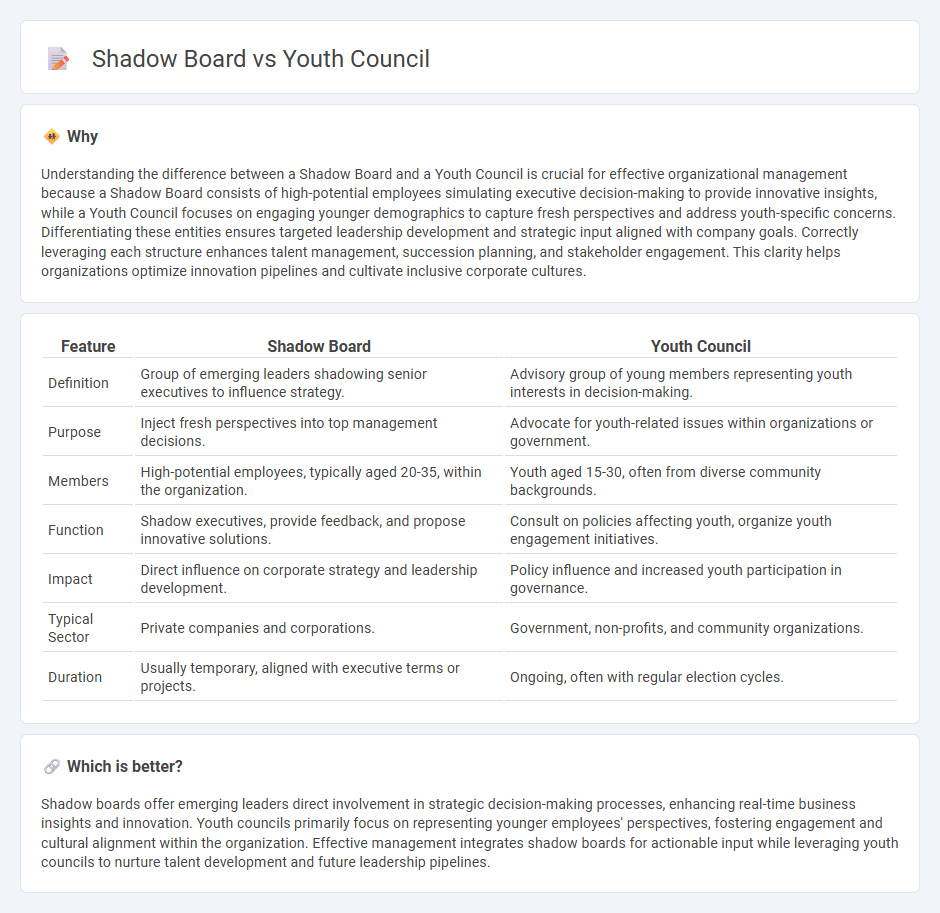
Shadow boards serve as strategic advisory groups composed of emerging leaders who provide innovative insights to senior management, enhancing decision-making processes. Youth councils focus on engaging younger demographics in organizational development, fostering leadership skills and ensuring their perspectives shape policies. Explore the distinctive roles and benefits of shadow boards and youth councils in modern management practices.
Why it is important
Understanding the difference between a Shadow Board and a Youth Council is crucial for effective organizational management because a Shadow Board consists of high-potential employees simulating executive decision-making to provide innovative insights, while a Youth Council focuses on engaging younger demographics to capture fresh perspectives and address youth-specific concerns. Differentiating these entities ensures targeted leadership development and strategic input aligned with company goals. Correctly leveraging each structure enhances talent management, succession planning, and stakeholder engagement. This clarity helps organizations optimize innovation pipelines and cultivate inclusive corporate cultures.
Comparison Table
| Feature | Shadow Board | Youth Council |
|---|---|---|
| Definition | Group of emerging leaders shadowing senior executives to influence strategy. | Advisory group of young members representing youth interests in decision-making. |
| Purpose | Inject fresh perspectives into top management decisions. | Advocate for youth-related issues within organizations or government. |
| Members | High-potential employees, typically aged 20-35, within the organization. | Youth aged 15-30, often from diverse community backgrounds. |
| Function | Shadow executives, provide feedback, and propose innovative solutions. | Consult on policies affecting youth, organize youth engagement initiatives. |
| Impact | Direct influence on corporate strategy and leadership development. | Policy influence and increased youth participation in governance. |
| Typical Sector | Private companies and corporations. | Government, non-profits, and community organizations. |
| Duration | Usually temporary, aligned with executive terms or projects. | Ongoing, often with regular election cycles. |
Which is better?
Shadow boards offer emerging leaders direct involvement in strategic decision-making processes, enhancing real-time business insights and innovation. Youth councils primarily focus on representing younger employees' perspectives, fostering engagement and cultural alignment within the organization. Effective management integrates shadow boards for actionable input while leveraging youth councils to nurture talent development and future leadership pipelines.
Connection
Shadow boards and youth councils both serve as strategic platforms that engage younger employees or members to provide fresh insights and innovative ideas within management processes. These groups influence decision-making by representing the perspectives of emerging talent, ensuring that leadership remains aligned with evolving market trends and workforce dynamics. Collaborative interaction between shadow boards and youth councils enhances organizational agility and fosters a culture of inclusive leadership development.
Key Terms
Representation
Youth councils provide structured platforms for young people to directly influence organizational decisions, ensuring their representation in policy-making processes. Shadow boards consist of emerging leaders or younger professionals who simulate executive board roles to offer fresh perspectives and challenge traditional leadership approaches. Explore the key differences and benefits of youth councils and shadow boards to understand which model best enhances youth representation within your organization.
Decision-making
Youth councils empower young people by providing a platform for direct input in community and organizational decisions, fostering leadership and civic engagement. Shadow boards consist of younger professionals who collaborate closely with senior executives to influence strategic decision-making processes within corporations. Discover how both models enhance youth participation in governance and corporate strategy by exploring their distinct roles and impacts.
Organizational influence
Youth councils empower young members with direct input on organizational policies, fostering leadership development and fresh perspectives. Shadow boards simulate executive decision-making, providing strategic recommendations while closely mirroring the senior leadership team's influence. Explore how each structure shapes organizational influence and drives innovation.
Source and External Links
Youth Council | Jackson, MI - The Jackson Youth Council is a 15-member group of middle and high school students advising the City Council on issues affecting children, families, and young adults in Jackson.
Youth Council - Youth councils are appointed or elected bodies that engage in community decision-making at various government levels, often serving as consultative bodies for other political entities.
Mayor's Youth Council | Boston.gov - The Boston Mayor's Youth Council is a citywide program empowering high school students to engage in civic leadership and community development through various projects and advisory roles.
 dowidth.com
dowidth.com